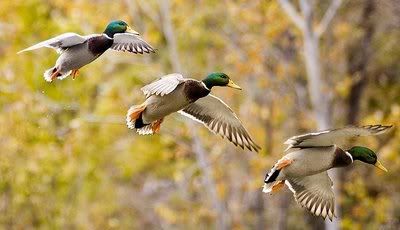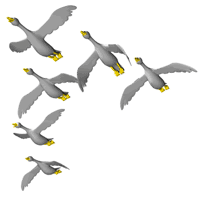Illinois Duck Hunting Seasons for 2008-09

Duck Hunting season for Illinois
The USFWS is again allowing a 60-day duck season with a daily bag limit of six ducks. This marks the 12th consecutive year in which hunters in Illinois have been offered a 60-day duck season.
The Illinois duck hunting season dates are as follows:
North Zone - Saturday, Oct. 18 - Tuesday, Dec. 16
Central Zone - Saturday, Oct. 25 - Tuesday, Dec. 23
South Zone - Thursday, Nov. 27 - Sunday, Jan. 25
The daily limit of six ducks may include no more than four mallards (two hens), three wood ducks, two redheads, one black duck, and one pintail.
Canvasback season is closed statewide for 2008-09.
The daily limit for scaup in each zone will vary during the season (limit of one for 40 days and two for 20 days) as follows:
North Zone scaup limits - Oct. 18-Nov. 3 and Nov. 24-Dec. 16 - daily limit of one
Nov. 4-Nov. 23 - daily limit of two
Central Zone scaup limits - Oct. 25-Nov. 10 and Dec. 1-Dec. 23 - daily limit of one
Nov. 11-Nov. 30 - daily limit of two
South Zone scaup limits - Nov. 27-Dec. 16 - daily limit of two
Dec. 17-Jan. 25 - daily limit of one
The daily bag limit for mergansers is five, only two of which may be hooded mergansers.
Possession limits are twice the daily bag limits.
The USFWS annual survey of key nesting areas indicated 37.3 million breeding ducks, 9 percent lower than last year's 41.2 million birds, and 11 percent above the 1955-2007 long-term average. In 2006 there were 32.6 million ducks and in 2005 there were 31.7 million ducks. More details on specific duck species are below:
• Mallards - The mid-continent mallard fall flight forecast is 9.2 million. The fall flight index predicts 1.3 million young mallards will fly south this year compared to two million last year. Young mallards are generally twice as vulnerable to hunting as adults.
• Pintails - The northern pintail population of 2.6 million was 22 percent lower than last year. Pintails remain 36 percent below their long-term average, but the population this year was above the threshold of 2.5 million, again justifying a full season length according to the USFWS interim pintail harvest strategy.
• Canvasbacks - The canvasback population dropped 44 percent from last year's record population to 489,000 and was 14 percent below the long-term average. Based upon this population estimate, the canvasback harvest strategy does not allow a nationwide canvasback season this year. As a result, the USFWS has closed the season on canvasbacks. Based on the harvest estimate from last year's seasons, it is clear that harvest alone is not responsible for the drop. Canvasback estimates typically have higher variation than for many other species. Although it is possible that the large change in the population estimate is the result of normal sampling variation, the USFWS has no data to suggest this year's population estimate is not accurate.
• Scaup - Scaup population estimates of 3.74 million increased 8 percent over last year, but are still 27 percent below the long-term average. There is no strong evidence indicating that hunting is the primary cause of scaup declines and many agencies continue to conduct research to understand reasons for the population decline. This year, the USFWS offered the Mississippi Flyway three options which would result in a reduction of scaup harvest. In the Flyway and Illinois, a decision has been made to allow two scaup to be taken daily during 20 consecutive days of the 60-day season. During the remaining 40 days, one scaup will be allowed daily. Illinois seasons were set to allow two scaup daily during the 20 days when past aerial survey data indicated that the most scaup would likely be present in Illinois in each zone.
• Wood Ducks - The USFWS has worked with the Atlantic and Mississippi Flyways during the past decade to assess harvest potential of wood ducks in eastern North America. A model-based approach was used to predict population responses to increased harvest. Results indicate that wood ducks can support more harvest pressure and the two eastern Flyways are being allowed to increase the wood duck bag limit from two to three birds daily this year. The USFWS and Flyway Councils will monitor wood duck harvest rates to ensure that bag limits remain in line with the harvest level that the population can support.
The preliminary 2007-08 Illinois duck harvest estimate of 464,366 was 8 percent lower than in 2006 (507,464) and was the sixth highest harvest since state estimates began in 1981. The harvest was 33 percent above the long term average (348,654). The North Zone harvested an estimated 81,338 ducks, while the Central took 224,200 and the South took 153,404 last year. Preliminary mallard harvest was 265,369, the sixth highest since 1981. According to federal estimates, Illinois hunters took more scaup (14,416) than any other state in the Mississippi Flyway last season. Harvest of teal during the 2007 September season was 29,800 compared to 28,016 in 2006.
The quality of habitat for breeding waterfowl in the U.S. and Canada was not as good as last year due to drought in parts of the traditional surveyed area. The estimate of May ponds for the northern U.S. and Prairie Canada was 4.4 million, which is 37 percent less than last year and 10 percent below the long term average. In Prairie Canada, there were 3.1 million ponds compared to 5 million last year. Green-winged teal are the third most harvested duck in Illinois after mallards and gadwalls. Green-winged teal populations again increased to the second highest level since 1955. Blue-winged teal were at their fourth highest level recorded. Redheads again reached a record population. Gadwalls decreased 19 percent from last year but were still 56 percent above the long term average. American wigeon populations decreased 11 percent and were 5 percent below the long term average. Experienced duck hunters know that individual hunter success is much more dependent on the weather during migration and on local water and food conditions at refuges and hunting areas. Many Illinois waterfowl areas along the Illinois River and at Lake Shelbyville and Carlyle Lake had high summer water levels which will likely cause poor duck food production. This could hurt hunting success on these areas this season. Rend Lake water levels have declined, which may result in decent moist-soil production.
September Teal Season for 2008
The statewide 16-day teal season is Sept. 6-21 from sunrise to sunset. The daily bag limit is four teal with a possession limit of eight


